Home Site Map - Steps - Foundations -
Prepare Site
Fence build site and protect
Orange fencing
Orange fencing is used to mark the perimeter of the build site. This is way bigger than the house footprint but in my case is way smaller than the whole plot. It needs to correspond with the building perimeter that is shown on your plot map drawing. It is particularly important to make sure it clearly provides protection for any trees you want to keep and protect...
In the picture below you can just see the orange fencing round the outside of the build site. The build site that is very much larger than the house footprint includes the entire area that will be disturbed by building activities, including where trucks park, where you will be changing the grade, and where will be cleared to create a lawn. You should think in terms of never having to set foot beyond the orange fence.
Survey and approximately stake the land
Objective: Transfer drawings to real land
This is the process of transferring your house plot drawings to the actual land. Particularly if the land is sloped, you will not be able to mark things accurately, but you need to try to get a close as possible. Measuring distances assumes that the measuring tape is level or else you will be measuring a hypotenuse (which is a longer length). You will need a bit of estimating and pragmatic judgment when measuring on a slope.
Establish basic location of the house
The first thing to do is to mark the important setbacks. In my case the most critical thing was the 100 foot building exclusion zone around the well. You need to measure the 100 foot accurately to make sure there is no danger of the house (including its foundations) being less than 100 feet. In my case the well cap was something like 18 foot lower than the house site so I fixed an 18 foot pole to the well casing and attached my 100 foot tape measure to the top of the pole. This let me measure 100 foot horizontally. I accurately marked the 100 foot circumference using stakes every 8 foot.
Other setbacks that may apply in your case include critical slopes, wetlands, streams, roads, easement roads, property boundaries, and possibly even the home of a rare animal. Your local planning office will be able to tell you the required setbacks that are needed in your area. For example in my area, a critical slope requires 50 foot of untouched vegetation plus an additional 15 foot that must not have a building, so the setback needed from the top of the slope is 65 feet.
Double check that you really have got all the setbacks correct. It's better to be safe than sorry, so if a setback of 65 feet is required from the top of a critical slope then make it at least 67 feet to allow for differing opinions on exactly where to measure from. A Well setback is typically 100 feet, but using 101 or 102 feet allows a safety margin. In my case I made the western wall of the house just over 124 feet from the well to allow for a 20 foot wide deck (deck foundations must not be within the 100 foot Well setback area).
Once you have the setbacks marked then you know where you are allowed to build and you can decide where within that you want to build.
Establish the house orientation
The next thing to do is decide which way you want the house to face. Typically you will want to try to back the house south, but there may be other things such as a view that will influence the orientation. Perhaps you want to have all the big windows aligned with a picturesque lake in the distance or a particular mountain. Start by stretching a taught colored string from a stake in about the center of where you want the house to be, to another stake in the direction of the object of interest that you want to align on. Look down the string to make sure it is exactly positioned right and adjust as necessary. Note that it is not necessary for the string to be to the center of the house because it is assumed that the thing you are aligning on is far enough in the distance for the sight lines to be essentially parallel wherever within the house footprint you set them from. The actual center of the house will be established by measuring from the various setbacks and reference lines relative to your plot map drawing. This string is now the reference for setting the orientation of the house. I call this the "North South" reference.
Establish north wall position
Now you need to establish another reference that sets where along the North South string the back wall of the house needs to be. Here you need to take into account any things on the site that you need to be set back from. In my case it was the septic system to the north of where the house will be. I needed to allow for a septic setback, a driveway, then a slope down to where the house foundations will be, and then the border needed round the foundations. Taking all this into account, you then position another reference string that sets the position of the north wall and is exactly perpendicular to the North South reference string. The new string I call the "East West" reference.
Iterative process
All of this is in practice an iterative process and very much needs to be done in conjunction with your plot map drawing. You should draw the two reference strings on your plot map and always keep the plot map up to date with any changes you make with the actual strings on the land.
It is useful to measure relative to existing buildings that are shown in the satellite photo. This will help you match up the plot map with the actual land.
You may discover things that you don't like about where you have decided to put your house and that may cause you to incrementally adjust the plot map.
Mark building edges and driveway with stakes
Once you have the two reference strings between stakes on the land and you have those same two reference lines marked on your plot map drawing, then everything else can be marked out with stakes from there. For any stake you want to position, use the plot drawing package to find the distance from the two references and then go outside with a tape measure to find that spot on the actual land.
Use a nice long (ideally 100 foot) tape measure to measure from your reference lines.
For stakes, I take 2x4s and rip them down the center with a table saw and then use a chop saw to make a point on the end. This makes stakes strong enough to be hammered in with a big club hammer. I needed more than 50 stakes to mark out my house and driveway.
On the plot map you should label key points of interest with letters (A, B, C, etc). Typical points of interest are the corners of the house, the edges of the driveway, and the edges of any decking.
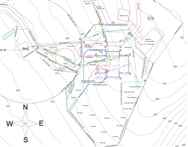
On the stakes, attach pieces of plastic (waterproof) "cardboard" (available from HomeDepot). Write with a waterproof marker pen the reference letter and a few description words.
Join the stakes with colored string
You want to make the house layout as clear as possible to help inspectors make sense of what you are proposing to build. You should use colored string to join up the stakes to form the outline of the building and the driveways etc.
Live the house
Having the house perimeter marked on the real land allows you to for example place a chair where the living room will be to see if you like the view. You can pretend to walk in through the front door, then go into the dining room and even setup a picnic table there and eat your lunch. Try to "live the house" to make sure you like everything. Perhaps even invite some friends over and give them a guided tour. Through this role playing, you might decide that moving the house a little to the left will allow you to get the view you want while also allowing you to keep a tree that you particularly like. Making this type of change now just involves moving pieces of string and is a lot easier than deciding later to move concrete walls!
Get into the habit of walking down the driveways defined by the colored strings and if you find yourself tempted to take short cuts then ask yourself if the driveway really is in the right place. The first users of the driveway to your house will likely be a very large truck with crushed stone and a very large concrete truck, so make sure that there is enough width and height clearance to allow for this.
Make sure you have the permit
You must not proceed past this point until you have a "Clearing and Grading" permit. Without a permit, even if you were to just do some light pruning of trees and some brush clearing you run the risk of annoying the inspectors. It's best to just leave the site completely untouched (apart from the fencing, the signs, and the string) until you have a permit.
Here is my permit (with the personal info removed)...



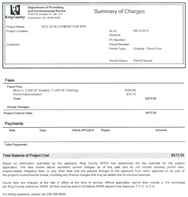
Clear trees
Save any plants
Before starting clearing, there may be plants in the house site that you want to transplant. Even in the wild forest there are small tree seedlings as well as Sword ferns, Oregon grape, and Salmonberry plants that are worth saving.
Mulch store
When clearing trees you will have a lot of leafy branches from your cutting. These are useful for scattering over newly excavated ground to help prevent soil erosion. You should form a pile to store it until it is needed. Any left over in the stockpile will rot down to make compost.
Felling the trees
Using a chainsaw, cut down the trees that are in the way of the building. If you are not sure if a tree will be in the way then it's best to leave it standing for the moment (because you can't put them back if you decide you want them). Cut the trunks into manageable lengths so you can transport them off the building site. I used my jeep and my tractor to drag them away. If you want them to be useful as lumber then try to keep the lengths greater than 12'6". Keeping them long gives flexibility even if you eventually decide to cut them later into 18" lengths for fire wood.
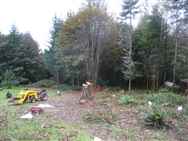
Get utilities marked
Free service
Before doing any digging it is important to know where any underground utilities are. For public utilities this is a free service provided by the city. They spray paint lines onto the ground. You need to be particularly careful that you don't hit an underground electrical cable as that would be particularly dangerous and may land you up in court. If you have a private Well and/or a septic then it's up to you to figure out if you are going to hit one of your own pipes. Try to do some trial digging with a spade to find water pipes. If you are not absolutely certain where the buried electricity lines are then turn the power off before digging.
Here's a trial trench I used to locate water pipes and electrical conduit...
After finding the pipes, mark the estimated path on the ground using colored spray paint.
Establish reference height for the excavation
Figure it out from your drawings and a laser level
On the plot map, draw a line that best reflects the direction of the slope, ie a line down the slope at its steepest point, perpendicular to the contours. I call this the "slope gradient line". In my case that happened to correspond to line from the septic system intake down to the position where I plan to put the sewage pump tank. The slope gradient line is the purple diagonal line in the diagram below.
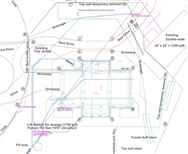
To establish accurately the slope gradient, place a laser level on a flat surface at the highest point and shine it along the slope gradient line. Measure down from the laser line at the various points of interest to establish the existing grade levels.
Using a stick with a white piece of card on the end is a good way to be able to see the red laser dot.
Draw this on a cross section diagram. Also decide what you would like the grade to be and draw that on the diagram.

It is assumed that you want a flat house site. The first stage of excavation will be to cut down to a level that will correspond to the top of the slab. This is 24" (2 foot) below grade level. (Looking on the foundation design drawings you will see that eventually the excavation under the slab will be 20" below the site leveling excavation level.) In the diagram below (that shows the profile for the footings), the green line represents the new grade if you are not doing any backfilling (which is 24" above the site leveling excavation).

Dig an excavation reference hole
Find the lowest point on the plot where there will be a house wall. If you have drawn the gradient line correctly, it will be the where the lowest point on the line cuts through a house wall.
Dig a hole at that point down until you hit good solid soil. In my case I was looking for the level at which the "Light gray Tokul" subsoil started. Certainly it wants to be well below any organic soil.
The bottom of the hole will be the reference point for the first phase house site leveling excavation. You will be asking the excavator guy to make the whole house site be level with the bottom of this hole.
It is possible that you might decide to set the reference level a bit lower if there are additional factors. These factors may include, bad soil conditions, a desire to sit the house lower for esthetic reasons, a desire to have the basement 51% buried so it does not count as a story, etc. In my case I was happy to do it as per the reckoning described above.
Here is a picture of my reference hole...
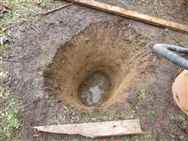
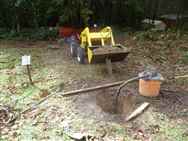
I found it useful to expand the reference hole to become a trench along a section of the slope gradient line. This corresponded to where the sewage and foundation drain will eventually run. I made the trench bottom gradually slope down from the reference hole reference height so it acted as a drain from the house site.
Remove the top soil
Save it for later use
Top soil will be very useful when you are creating flower beds around the house later. Top soil is very valuable stuff because it takes nature a long time to make it. You strip it off the house site and store it somewhere in your yard for later use.
Even though using a tractor to scrape off the top soil seems like a cool way of doing it, in practice most of the top soil in my case was done with shovels and moved with buckets. A nice thing about doing it by hand is that you can be more selective about what is the best soil and you pick out the stones as you go.
The official way of doing it is with an excavator, but this kind of finicky digging can get expensive when you are paying $100 per hour.
However you remove the top soil, you need to stockpile it in an officially designated place. That official place should be marked on your plot map.

This shows the top soil pile just starting to be formed...
And here's the final pile, now covered in mulch to protect it...
You can also use tarps to cover your soil piles...
The following pictures show the site ready for excavation. The good top soil has been removed. Areas with poor top soil have been left untouched.
Excavate the site to level
In my case there was a huge amount of excavating to do. I needed to take a hillside with a 1 in 7 slope and cut it flat over the whole house site and a bit beyond. It needed a heavy duty excavator - a 120, which is the biggest you can move on public roads without needing the large cost of an exceptional convoy.
The excavator has wide tracks so you need a nice wide access road to the site.
Clearly mark on the ground with spray paint the area that you want dug. The clearer you make things the less time and money will be wasted.
Excavation Day 1
The first big job is to dig out the tree stumps.
Felling trees by cutting the trunk with a chain saw is easy (although great care is necessary to avoid injury). The hard part is getting the roots out from the ground, and it is necessary to get the roots out from under the house area. There are various strategies for getting the roots out, but most methods involve using heavy machinery ie an excavator. If the tree is not too big then you may be able to topple it over (roots and all) by pushing on the trunk with the digger. If that doesn't work then cut the trunk near ground level and dig around the roots with the digger until the stump is free enough to be lifted out by the excavator.
And move the stumps out of the way.
Starting the slope down.
The earth dug is formed into a mound that is gradually moved backwards.
While the excavator is doing its thing, you need to scavenge rocks and cart them off to a rock pile for saving. Rocks are a really useful resource so definitely worth saving even though it's a lot of work.
The following two photos are after one day's digging.
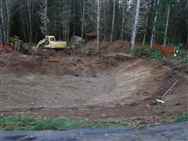
Excavation Day 2
Excavation Day 3
Excavation Day 4
Excavation Day 5
Excavation Day 6
Excavation Day 7/8
The last day is mainly about getting the ground level by using a laser.
Here is the site all nicely leveled...
My ground type
In my case the subsoil a few feet down is what's called "Light gray Tokul". It is deposited by several glaciers and is sometimes referred to as "glacier till". This is very solid ground that some people liken to concrete. It forms a great base to build a house on. With the completed excavation, the entire flat area is down to this Light Gray Tokul.
Stabilize the soil
You need to avoid the soil being washed away when it rains or being blown away in high winds. This is done by spreading mulch from your mulch stockpile over the soil or plastic sheeting soon after it is excavated. Also scatter grass seed all over. Transparent plastic over the grass seed helps it get started more quickly and in colder weather. Once the grass starts growing you can gradually remove the mulch and/or plastic sheeting.
Implement French drain along edge of site
Important to keep building site dry
It is a real pain if water runs through your house building site when it rains. It can cause foundation trenches to cave-in, and sand and gravel to be washed away. If your building site is sloped then ideally before digging the footings or at least straight away after you need to implement a drainage channel along the uphill border of the site to catch surface rainwater before it runs down the slope. See details here .
You may also get water running out of the slope itself. Water often flows in the different layers in the ground and you will be cutting through the layers. It may well be necessary to implement a temporary drain ditch at the bottom of the cut slope if you find you have a water problem (luckily I didn't).
Keep excavation dry
The excavated area is a huge flat area with very solid soil, so it is going to collect rain water. You can place a sump style water pump in a convenient place, connected to a hose pipe, and run it after heavy rain falls.







